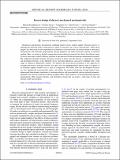| dc.contributor.author | Ronellenfitsch, Henrik | |
| dc.contributor.author | Stoop, Norbert | |
| dc.contributor.author | Yu, Josephine | |
| dc.contributor.author | Forrow, Aden | |
| dc.contributor.author | Dunkel, Jörn | |
| dc.date.accessioned | 2021-10-27T20:35:46Z | |
| dc.date.available | 2021-10-27T20:35:46Z | |
| dc.date.issued | 2019 | |
| dc.identifier.uri | https://hdl.handle.net/1721.1/136520 | |
| dc.description.abstract | © 2019 American Physical Society. Mechanical and phononic metamaterials exhibiting negative elastic moduli, gapped vibrational spectra, or topologically protected modes enable precise control of structural and acoustic functionalities. While much progress has been made in their experimental and theoretical characterization, the inverse design of mechanical metamaterials with arbitrarily programmable spectral properties and mode localization remains an unsolved problem. Here, we present a flexible computational inverse-design framework that allows the efficient tuning of one or more gaps at nearly arbitrary positions in the spectrum of discrete phononic metamaterial structures. The underlying algorithm optimizes the linear response of elastic networks directly, is applicable to ordered and disordered structures, scales efficiently in two and three dimensions, and can be combined with a wide range of numerical optimization schemes. We illustrate the broad practical potential of this approach by designing mechanical band-gap switches that open and close preprogrammed spectral gaps in response to an externally applied stimulus such as shear or compression. We further show that the designed structures can host topologically protected edge modes, and validate the numerical predictions through explicit three-dimensional finite-element simulations of continuum elastica with experimentally relevant material parameters. Generally, this network-based inverse design paradigm offers a direct pathway toward manufacturing phononic metamaterials, DNA origami structures, and topoelectric circuits that can realize a wide range of static and dynamic target functionalities. | |
| dc.language.iso | en | |
| dc.publisher | American Physical Society (APS) | |
| dc.relation.isversionof | 10.1103/PHYSREVMATERIALS.3.095201 | |
| dc.rights | Article is made available in accordance with the publisher's policy and may be subject to US copyright law. Please refer to the publisher's site for terms of use. | |
| dc.source | APS | |
| dc.title | Inverse design of discrete mechanical metamaterials | |
| dc.type | Article | |
| dc.contributor.department | Massachusetts Institute of Technology. Department of Mathematics | |
| dc.contributor.department | Massachusetts Institute of Technology. Department of Physics | |
| dc.relation.journal | Physical Review Materials | |
| dc.eprint.version | Final published version | |
| dc.type.uri | http://purl.org/eprint/type/JournalArticle | |
| eprint.status | http://purl.org/eprint/status/PeerReviewed | |
| dc.date.updated | 2021-05-19T12:22:42Z | |
| dspace.orderedauthors | Ronellenfitsch, H; Stoop, N; Yu, J; Forrow, A; Dunkel, J | |
| dspace.date.submission | 2021-05-19T12:22:44Z | |
| mit.journal.volume | 3 | |
| mit.journal.issue | 9 | |
| mit.license | PUBLISHER_POLICY | |
| mit.metadata.status | Authority Work and Publication Information Needed | |
